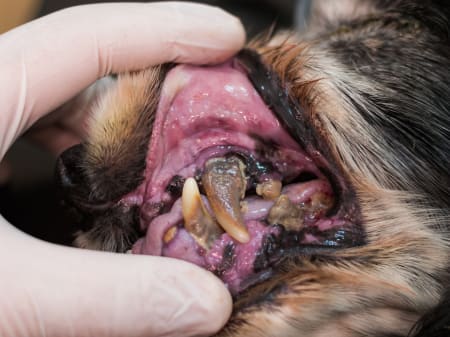What is periodontal disease?
Periodontitis is a bacteria that can infect your dog’s mouth. Typically, this silent disease doesn’t show any obvious signs or symptoms until it advances.
However, gum disease can cause chronic pain, tooth loss, gum erosion and bone loss. The supporting structures of the teeth are weakened or lost.
When food and bacteria build up along the gums and are not brushed away, they can develop into plaque, which hardens into a calculus we refer to as tartar.
This leads to inflammation and irritation in the gums (gingivitis), and is an early stage of gum disease.

In the second stage, the attachment between gums and teeth starts to become lost, which intensifies in stage third stage and becomes advanced periodontal disease in the fourth stage, which is marked by receding gum tissue, loss of 50% of the attachment between teeth and gums, and exposure of tooth roots.
What are symptoms of periodontal disease in dogs?
Here are some symptoms of canine periodontitis to watch for:
- Bad breath (halitosis)
- Discolored teeth (yellow or brown)
- Loose or missing teeth teeth
- Inflamed or bleeding gums
- Blood on chew toys or in water bowl
- Excessive drooling
- Irritability
- Favoring one side of the mouth when chewing
- Problems keeping food in mouth
- Reduced appetite
- Weight loss
- Bloody or “ropey” saliva
By the time the disease has advanced, your dog may be in significant chronic pain, which our pets tend to instinctively hide to avoid showing weakness to predators. Periodontal disease doesn’t remain confined to your dog’s mouth - it can also cause problems with major organs and lead to heart disease after bacteria from the mouth gets into the bloodstream, then attaches to arteries around the heart.
What causes periodontal disease?
The buildup of bacteria in a dog’s mouth eventually develops into plaque, which combine with other minerals and harden within two to three days. Once calculus forms on the teeth, it becomes more difficult to scrape away.
Once the immune system begins to fight this buildup of bacteria, we see inflamed gums and more obvious signs of the disease.
Poor nutrition and diet can play a factor. Other environmental contributors such as dirty toys or grooming habits (if your pup licks himself frequently), the alignment of teeth (dogs with crowded teeth are more vulnerable to gum disease), and oral hygiene pile on.
How is periodontal disease in dogs treated?
The cost of a professional teeth cleaning or other dental procedure can vary widely depending on the level of care your veterinarian can provide, your pet’s requirements, and other factors. Pre-anesthesia blood work is an important step to determine whether your pet is healthy enough for anesthesia medications, which may spell trouble for dogs with organ disease.
Any dental procedure should include:
- A complete set of dental radiographs
- Pre-anesthesia blood work
- IV catheter and IV fluids
- Endotracheal intubation, inhaled anesthetic and oxygen
- Circulating warm air to ensure patient remains warm while under anesthesia
- Anesthesia monitoring
- Scaling, polishing and lavage of gingival areas
- Any extractions that may be required, local anesthesia such as novocaine
- Pain medication during and post-procedure
How can I prevent my dog from getting periodontal disease?
Fortunately, periodontal disease in dogs can be prevented, treated and reversed if detected early.
Don’t neglect your dog’s oral health. Just like us, they need regular dental appointments to keep their oral hygiene in check and identify any trouble spots. Your pooch should see your vet at least once every six months for an oral health evaluation. You’ll also have the opportunity to ask any questions you may have about at-home care, as well as find out how often your pet should come in for professional teeth cleanings.
Prevent problems from taking hold between appointments by brushing your dog’s teeth daily to prevent plaque and bacteria from forming (choose a toothpaste specially made for dogs).
There are also chew toys, dog food and dental chews specifically designed to address dental disease and reduce the development of tartar (but don’t attempt to use these to replace brushing - they are a supplement to regular oral care). If you notice swollen or inflamed gums, appetite changes or missing teeth, book an appointment immediately.
